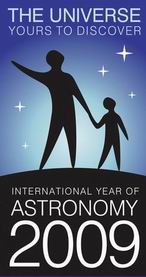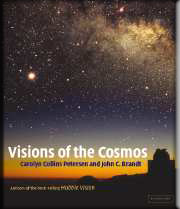 |
 The SpaceWriter's Ramblings |
 |
||
|
|
|
|
||
|
Anything and everything about science, especially astronomy and the cosmos. NOTE: This blog has migrated to a new address. Please update your favorites link accordingly.Visit my web site at Posting times are Powered by
|
2.24.2005 Paradigm Shifty ThingsA while back I wrote about this huge video project we've undertaken at the company my husband and I run. Basically it all stems from the planetarium world changing from a realm of starballs and slide projectors to a realm where digital video also paints the dome. The change represents a huge leap from making slides and figuring out how to move them around the dome (using mirrors to reflect images, etc.) to learning video production tools and being worried about resolution and rendering times. All this before you put a single image on the dome or a single word down on tape for the soundtrack. (Tape? What's tape? These days it's all digital audio!). Most of us grew up going to see a planetarium instrument that looked something like the ones below.
Lots of memories around those lovely projectors! I first learned to work one at Fiske Planetarium in Boulder, Colorado. There is NOTHING like taking the controls of a star instrument and literally making the universe do what you want it to! Now, mind you, those instruments aren't going away, even in this new realm of fulldome video. Some theaters are replacing their opto-mechanical systems with video, but some are opting to have BOTH types of projection systems under one dome. So, next time you walk into your local planetarium, you might see one of those instruments above, but there might also be something that looks like a box with a huge lens on top of it, all controlled by a computer (maybe even a laptop). How does this affect us? Well, now we get to be video production types, taking the shows we used to do with slides and mirrors, and applying all the latest techniques to fulldome video production. It's a huge paradigm shift, to be sure. But it's also challenging and fun and stimulating. posted by CCP on 2/24/2005 11:31:00 AM | *2.20.2005 Wanna Do Some Science?I've been running Seti@Home on my computer for a few years now and have managed to crank out a few thousand work units for the cause. Its seems like an easy-enough contribution to science: donate unused computer cycles to some giant distributed-computing project. I like the screensaver—it's spiffy-looking and gives me some idea of the progress my machine is making as it crunches data from stellar signals. So, why not try it? If you're interested, you can sign up and get started over at If searching for signals from ET isn't your cup of tea, maybe you'd like to help out with some astrophysical researchers trying to detect gravitational waves. These are ripples in the fabric of space and time, emanating from such violent events in the cosmos as black hole collisions and supernovae, the action around rapidly rotating compact stars, and between active members of binary systems. These ripples travel through space, carrying information both about their source and about the nature of gravity itself. And there are two groups of astrophysicists trying to detect them: the LIGO and the GEO-600 collaboration. Their measurements are producing data that needs crunching, and why not use the world's desktops as a powerful tool, just as the Seti@Home folks do with their distributed computing? If you're interested in that project, you can visit the Einstein@Home project. These are two of many other distributing computer projects that make solid contributions to science every day. I think it's pretty cool that people and their home computers can be a part of Big Science! posted by CCP on 2/20/2005 11:57:00 AM | *2.16.2005 Saturn's Aurorae on the Move Saturn's Dynamic Aurorae Seen by Hubble Space TelescopeEver since the Pioneer and Voyager missions to the outer planets in the late 70s and early 80s, planetary scientists have known about Saturn's aurorae. Hubble Space Telescope scientists have tracked the eerie glows over the past decade and a half using ultraviolet filters and instruments to study the characteristics of these emissions-related events. Recent studies using the Hubble Space Telescope and Cassini spacecraft show that the dancing light of the auroras on Saturn behaves in ways different from how scientists have thought possible for the last 25 years. To get the image above, astronomers combined HST and Cassini ultraviolet images of Saturn's southern polar region with visible-light images of the planet and its rings to make this picture. The auroral display appears blue because of the glow of ultraviolet light. In reality, the aurora would appear red to an observer at Saturn because of the presence of glowing hydrogen in the atmosphere. On Earth, charged particles from the Sun collide with nitrogen and oxygen in the upper atmosphere, creating auroral displays colored mostly green and blue. If you click on the image above, you'll see a "movie" of the Saturnian aurorae,dancing around the auroral "oval" at one of the planets' poles. For more pictures and videos, visit the European Space Agency's Hubble releases page. posted by CCP on 2/16/2005 09:14:00 PM | *2.15.2005 Astronomy for Everybody and Eyeballs to AdvertisersBack when I was an editor at Sky & Telescope I became very familiar with the astro-products "industry." One of my jobs was to help select stuff to sell in the S&T catalog and through the online store from among all the astronomy- and space science-related products out there. Of course I expected to see books and posters and telescope-related products (and there are a LOT of them). It was always tough to choose from among the "best" and "most useful" or "most woweeeeee!!" from the wide selection of materials that would make their way to my desk. We had some selection criteria that were specific to our shop, and the merchandisers would try to meet those requirements in order to get their stuff in our catalog. It was often interesting and sometimes downright puzzling what companies would send us that they thought our readers might like. We had to draw the line somewhere, and so while some products were a natural fit, others never made it into the mix. One of our rules (out of many) was that a product had to appeal to our reader base. And that, of course, meant we had to KNOW our readers and anticipate what they wanted. I find myself in much the same situation with this website and blog. I'm in the great position of being able to use this space to write about my interests in astronomy, space science, exploration, science fiction, and all the related sciences and political topics. Readers seem to like it (judging from the e-mails I get (and the occasional brave soul who leaves comments)) and so that's where this site continues to head. I know that a great many students read my site, as do other astronomers and writers. It's important to me that this site be a safe and honest forum through which we can explore the sciences of astronomy and space exploration AS SCIENCES with their own unique requirements and culture. I offer astronomy to everybody, but I also know that there's a huge Web of Astro-Stuff out there that I may not ever get a chance to write about. However, I CAN and DO point you to stuff I think you'd like. Some of your e-mail feedback messages ask about products, with time-honored questions like, "I want to get something for my honey, and she's into astronomy" or "My husband just bought a telescope and I want to get him an astronomy book or some software" or "My child is working on a school project in astronomy and what should I get to help him/her learn more about the stars?" Sure, I've written about some products, and will continue to do so. Think of this place as a portal to material and products that are complementary with what I'm writing about here. As you read my pages, you'll see direct links to other Web pages, organizations, companies, and institutes. While many of those links are free (meaning not sponsored by an advertiser), some are paid. Lately, I've also opened some of my pages (including this blog) to Google Ads and Google search bars, as well as links to products at Amazon.com. Not only does this widen the portal I've opened, it also provides support for the upkeep of the site (since I pay for my web space out of my own pocket). If you click on one of the Google ads or search buttons, Google diverts a few cents my way. If you buy any of the products I've linked to on Amazon.com, they, too will send a little share my way. If you click on a paid link, you go that site for a more directed message. It doesn't cost YOU anything, except a little eyeball time with an advertiser who wants to sell you something. I monitor these ads and links daily to make sure that they're appropriate for my readers and true to the mission of this site. Fortunately, about 90 percent of the ads are fine. The other 10 percent are not, and so I filter them out. As usual, with any site, however, things can change. And an advertiser or site which I've linked to as "on message" or "safe" today, could be "off target" or "not so safe" in the future. As we all know, there's a lot of useful information out there in the Information Superstructure. But there's also the non-useful stuff, and we all have to be discerning and read these things with a critical eye. posted by CCP on 2/15/2005 11:12:00 AM | *2.13.2005 Cosmic Greetings Happy Valentine's Day |

Earth Hour! Do it for the Planet!
Blog RollPlanetarium-relatedLoch Ness ProductionsPurveyors of fine planetarium shows, music, and services. INTENSELY Good Space Music from a master in the genre! My cool astronomy cause: ScienceThe sites below belong to space and astronomy enthusiasts. I make every effort to check them and make sure they are still appropriate. However, I am not responsible for their content, nor do I endorse any of it by simply linking to them. As with all Web surfing, please exercise caution. Adot's Notblog A fellow traveler blogger and astronomy enthusiast! Astronomy Blog An astronomy blog pondering the big questions Astronomy Cast Astronomy Podcasting from Pamela Gay BadAstronomy.com Bad astronomy discussed and debunked along with fun stuff about really good astronomy! Chris Lintott's Universe Musings from an Oxford Astronomer. Cosmic Variance Random Samplings from a Universe of Ideas. Dave P's Astronomy blog Observational Astronomy and other TidBits European Southern Observatory Fine Ground-based astronomy images. Gemini Observatory Fine astronomy in infrared and visible wavelengths. Griffith Observatory's page. I wrote their exhibits! Observing The Sky Nightly Observation Reports from dedicated skygazers. The Official String Theory Web Site. Time to feed your mind! Pharyngula Evolution, development, and random biological ejaculations from a godless liberal. Cast off your blinders and come on in! Science Made Cool A compendium of discoveries, inventions and commentary. Slacker Astronomy Astronomy with a Slacker Twist. Space Telescope Science Institute The best from Hubble Space Telescope The Eternal Golden Braid Astronomy, Space Science, and Science Fiction Commentary. The Inoculated Mind Bills Itself as a weekly science mindcast. Thought-provoking, honest. Truth. UniqueThe Hairy Museum of Natural History
|










